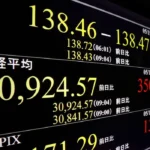Yesterday’s trade saw USD/JPY within the range of 124.49-125.23. The pair closed at 125.13, soaring 0.40% on a daily basis and extending gains from Monday. The daily high has also been the highest level since June 8th, when the cross registered a high of 125.69.
At 8:45 GMT today USD/JPY was down 0.48% for the day to trade at 124.53. The pair overcame the lower range breakout level (S4) and touched a daily low at 124.32 at 7:50 GMT. It has been the lowest level since this Monday, when a daily low of 124.12 was reached.
USD/JPY was heavily influenced by increased demand for haven assets, such as the yen, amid the sharp two-day depreciation of the Chinese yuan and concerns over a currency war. In addition, today the cross may be influenced by a number of macroeconomic reports as listed below.
Fundamentals
United States
Job Openings
The number of job openings in the United States probably dropped a second month in a row to reach 5.300 million in June from 5.363 million in May. If so, Junes figure would be the lowest one since March, when 4.994 million job openings were reported. This indicator refers to all positions that are open, but not filled on the last business day of the month. Job openings are part of the Job Openings and Labor Turnover Survey (JOLTS), which gathers data from about 16 400 non-farm establishments including retailers and manufacturers, as well as federal, state, and local government entities in the 50 states and the District of Columbia. The survey assesses the unmet demand for labor in the labor market. Lower-than-projected number of openings will usually mount selling pressure on the US dollar. The Bureau of Labor Statistics is to release the official data at 15:00 GMT.
Monthly Budget Statement
The United States probably recorded a government budget deficit of USD 113.5 billion in July, according to market expectations, after a surplus of USD 51.8 billion during the previous month. If so, the July deficit would be the most considerable one since February, when a gap of USD 192 billion was reported. The June surplus represented a 27% decrease compared to the same month a year ago. In June total receipts were at the amount of USD 342.9 billion, or up 6% compared to June 2014, while total outlays amounted to USD 291.2 billion, or a 15% increase from a year earlier. In June, the government usually generates a surplus, due to the collection of corporate and individual taxes at end of the month.
In the 12 months to June the budget deficit was at the amount of USD 431 billion, which represented a drop of almost 20% compared to the preceding 12 months, according to the report by the US Treasury. It has been the second lowest 12-month deficit figure since August 2008.
A larger-than-projected budget deficit would have a moderate bearish effect on the greenback. The Financial Management Service is to publish the official figure at 18:00 GMT.
Japan
Machinery Orders
Machinery orders in Japan probably dropped 5.6% in June compared to a month ago, according to the median forecast by experts, after three consecutive monthly increases. In annual terms, new orders, placed at major manufacturers in Japan, probably rose 16.4% in June. If so, this would be the seventh month in a row, during which machinery orders went up. In May new orders increased at an annualized rate of 19.3%, or the sharpest one since January 2014, when they surged 23.6%.
Machinery orders are considered as an excellent leading indicator, providing clues over business capital spending in Japan. An increase in new orders suggests that business confidence has strengthened, which can also raise hopes over the nations economic growth. Therefore, in case new orders increased at a faster-than-anticipated pace, this would provide a positive impulse for the yen. Japanese Cabinet Office will release the official report at 23:50 GMT.
Bond Yield Spread
The yield on Japanese 2-year government bonds went as high as 0.013% on August 11th, or the highest level since August 6th (0.014%), after which it slid to 0.010% at the close to lose 0.001 percentage point on a daily basis.
The yield on US 2-year government bonds climbed as high as 0.729% on August 11th, after which it fell to 0.681% at the close to lose 4.8 basis points (0.048 percentage point) for the day. It has been the first drop in the past three trading days.
The spread between 2-year US and 2-year Japanese bond yields, which reflects the flow of funds in a short term, shrank to 0.671% on August 11th from 0.718% during the prior day. The August 11th yield difference has been the lowest one since August 3rd, when the spread was 0.654%.
Meanwhile, the yield on Japan’s 10-year government bonds soared as high as 0.420% on August 11th, after which it slid to 0.406% at the close to lose 0.002 percentage point compared to August 10th, while marking a third consecutive trading day of decrease.
The yield on US 10-year government bonds climbed as high as 2.232% on August 11th, after which it slipped to 2.150% at the close to lose 8.2 basis points (0.082 percentage point) on a daily basis.
The spread between 10-year US and 10-year Japanese bond yields narrowed to 1.744% on August 11th from 1.824% during the prior day. The August 11th yield difference has been the lowest one since August 3rd, when the spread was 1.734%.
Taking into account the period January-July 2015 and basing our calculations on weekly closing prices, we came to the conclusion that USD/JPY performance and the development of the yield spread between 10-year bonds in the United States and Japan showed a correlation of 0.8255, or the pair and the spread moved quite strongly in one and the same direction. As the yield spread grew in favor of the 10-year US bonds, the US dollar gained ground against the Japanese yen. During the period January-July, USD/JPY has appreciated 4.56%, while the spread between 10-year bond yields in both countries has widened 6.41% to reach approximately 1.78% in late July from approximately 1.67% in early January.
Daily and Weekly Pivot Levels
By employing the Camarilla calculation method, the daily pivot levels for USD/JPY are presented as follows:
R1 – 125.20
R2 – 125.27
R3 (range resistance – green on the 30-minute chart) – 125.33
R4 (range breakout – red on the 30-minute chart) – 125.54
S1 – 125.06
S2 – 124.99
S3 (range support – green on the 30-minute chart) – 124.93
S4 (range breakout – red on the 30-minute chart) – 124.72
By using the traditional method of calculation, the weekly pivot levels for USD/JPY are presented as follows:
Central Pivot Point – 124.36
R1 – 124.94
R2 – 125.67
R3 – 126.25
S1 – 123.63
S2 – 123.05
S3 – 122.32





